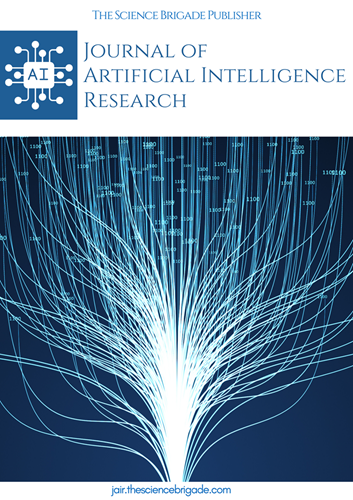AI in Dental Imaging: Advancements and Applications for Diagnosis and Treatment Planning
Keywords:
Artificial intelligence, Dental imaging, Image analysis, Segmentation, Diagnosis, Treatment planning, Machine learning, Deep learning, Dental conditions, ResearchAbstract
Artificial intelligence (AI) has revolutionized various fields of medicine, and dentistry is no exception. This paper explores the advancements and applications of AI in dental imaging, focusing on image analysis, segmentation, and interpretation. AI techniques such as machine learning and deep learning have enabled remarkable progress in diagnosing dental conditions and planning treatments. This abstract provides an overview of key developments and their implications in dental practice and research.
References
Alghayadh, Faisal Yousef, et al. "Ubiquitous learning models for 5G communication network utility maximization through utility-based service function chain deployment." Computers in Human Behavior (2024): 108227.
Pulimamidi, Rahul. "Emerging Technological Trends for Enhancing Healthcare Access in Remote Areas." Journal of Science & Technology 2.4 (2021): 53-62.
Raparthi, Mohan, Sarath Babu Dodda, and Srihari Maruthi. "AI-Enhanced Imaging Analytics for Precision Diagnostics in Cardiovascular Health." European Economic Letters (EEL) 11.1 (2021).
Kulkarni, Chaitanya, et al. "Hybrid disease prediction approach leveraging digital twin and metaverse technologies for health consumer." BMC Medical Informatics and Decision Making 24.1 (2024): 92.
Raparthi, Mohan, Sarath Babu Dodda, and SriHari Maruthi. "Examining the use of Artificial Intelligence to Enhance Security Measures in Computer Hardware, including the Detection of Hardware-based Vulnerabilities and Attacks." European Economic Letters (EEL) 10.1 (2020).
Dutta, Ashit Kumar, et al. "Deep learning-based multi-head self-attention model for human epilepsy identification from EEG signal for biomedical traits." Multimedia Tools and Applications (2024): 1-23.
Raparthy, Mohan, and Babu Dodda. "Predictive Maintenance in IoT Devices Using Time Series Analysis and Deep Learning." Dandao Xuebao/Journal of Ballistics 35: 01-10.
Kumar, Mungara Kiran, et al. "Approach Advancing Stock Market Forecasting with Joint RMSE Loss LSTM-CNN Model." Fluctuation and Noise Letters (2023).
Raparthi, Mohan. "Biomedical Text Mining for Drug Discovery Using Natural Language Processing and Deep Learning." Dandao Xuebao/Journal of Ballistics 35
Sati, Madan Mohan, et al. "Two-Area Power System with Automatic Generation Control Utilizing PID Control, FOPID, Particle Swarm Optimization, and Genetic Algorithms." 2024 Fourth International Conference on Advances in Electrical, Computing, Communication and Sustainable Technologies (ICAECT). IEEE, 2024.
Raparthy, Mohan, and Babu Dodda. "Predictive Maintenance in IoT Devices Using Time Series Analysis and Deep Learning." Dandao Xuebao/Journal of Ballistics 35: 01-10.
Pulimamidi, Rahul. "Leveraging IoT Devices for Improved Healthcare Accessibility in Remote Areas: An Exploration of Emerging Trends." Internet of Things and Edge Computing Journal 2.1 (2022): 20-30.
Reddy, Byrapu, and Surendranadha Reddy. "Evaluating The Data Analytics For Finance And Insurance Sectors For Industry 4.0." Tuijin Jishu/Journal of Propulsion Technology 44.4 (2023): 3871-3877.
Downloads
Published
How to Cite
Issue
Section
License

This work is licensed under a Creative Commons Attribution-NonCommercial-ShareAlike 4.0 International License.
License Terms
Ownership and Licensing:
Authors of this research paper submitted to the journal owned and operated by The Science Brigade Group retain the copyright of their work while granting the journal certain rights. Authors maintain ownership of the copyright and have granted the journal a right of first publication. Simultaneously, authors agreed to license their research papers under the Creative Commons Attribution-NonCommercial-ShareAlike 4.0 International (CC BY-NC-SA 4.0) License.
License Permissions:
Under the CC BY-NC-SA 4.0 License, others are permitted to share and adapt the work, as long as proper attribution is given to the authors and acknowledgement is made of the initial publication in the Journal. This license allows for the broad dissemination and utilization of research papers.
Additional Distribution Arrangements:
Authors are free to enter into separate contractual arrangements for the non-exclusive distribution of the journal's published version of the work. This may include posting the work to institutional repositories, publishing it in journals or books, or other forms of dissemination. In such cases, authors are requested to acknowledge the initial publication of the work in this Journal.
Online Posting:
Authors are encouraged to share their work online, including in institutional repositories, disciplinary repositories, or on their personal websites. This permission applies both prior to and during the submission process to the Journal. Online sharing enhances the visibility and accessibility of the research papers.
Responsibility and Liability:
Authors are responsible for ensuring that their research papers do not infringe upon the copyright, privacy, or other rights of any third party. The Science Brigade Publishers disclaim any liability or responsibility for any copyright infringement or violation of third-party rights in the research papers.




